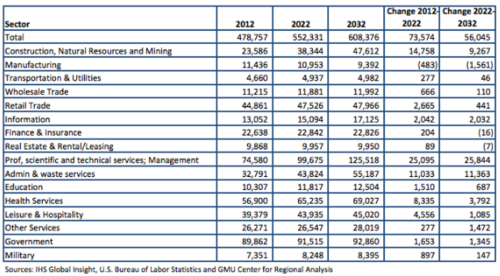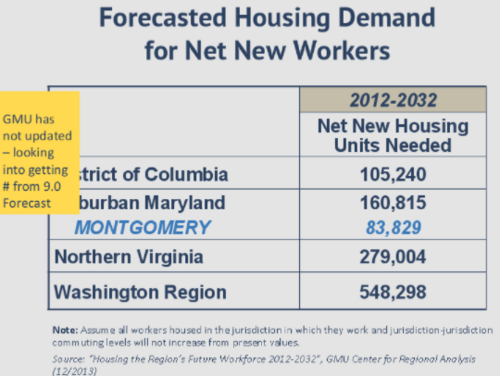To make room for future workers, Montgomery County needs to build 4,200 new housing units per year
More and more jobs are coming to Montgomery County, and the workers taking them need places to live. The county’s planning office recently created a few graphics showing that while Montgomery is building enough housing units, they aren’t necessarily lining up with what workers will be able to afford.
In 2013, George Mason University released a study forecasting the region’s anticipated housing needs.
The study said that between 2012 and 2032, Montgomery would add 129,619 jobs and that to accommodate that growth, it will need to add 83,829 new housing units. In a recent presentation on growth trends, planners at the Montgomery County Planning Board Chair’s office highlighted a few key takeaways about the intersection between the county’s coming job growth and its housing market.
Factoring what’s been built between 2012 and now, that means the county needs to incorporate about 4,200 units per year moving forward. Meeting this figure wouldn’t mean a crazy building spree. It just means that as Montgomery County grows, it needs to expect to build reasonable amounts of new housing to meet that growth.
It’s not just about adding any housing. It’s about adding the right mix of housing types.
All of the jobs expected to come to Montgomery don’t pay the same, which means it makes sense to think that new housing built in Montgomery County shouldn’t cater to only one income bracket.
Here’s a list of the types of jobs likely to come to Montgomery:

Job forecasts from GMU’s Housing the Region’s Future Workforce study.
Unfortunately, the Montgomery planners point out that when you look at the needs indicated by GMU study’s job projections and compare them to housing currently on the market in the county, there are some big gaps.
It’s likely that there just won’t be that many workers looking to buy at the high end of the housing market, but that there will be quite a few wanting to buy at the low end. If the housing supply continues to look the way it does now, a lot of market rate housing will not be affordable to the incoming workforce:
Of course, not everyone is going to buy a house. But the picture is similarly bleak for renters:
For those making the minimum wage, even affording a studio (with “affording” meaning paying 30% or less of your income) would require making more than two and half times what you do. But if you look above those making the least and examine the average wages of those who rent, we see even they are nearly 27% short of earning what they need to afford a one-bedroom on their own.
Clearly the current housing opportunities do not match the needs of the incoming workforce.
The county is starting to build more, which will need to continue
The latest building permit data for the county shows that supply is starting to catch back up with demand. The graph below shows past permit data (blue) matched with what the George Mason study forecasted future need to be (4,200 units a year, in green):
While the 20-year average (3,510 units) is lower than what is needed, that doesn’t tell the full story. In many years, Montgomery exceeded the needed 4,200 units, and last year it was only a few units short; the big dip was because of the 2008 recession.
That’s a good sign for anyone hoping the county will keep pace with the demands of a growing region and workforce.





